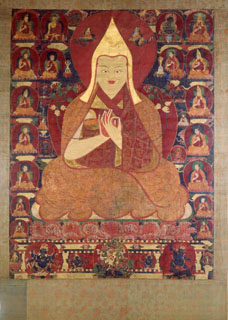The occasion for this week’s picture is the birthday of the Dalai Lama, which falls on this day. The work in question is a fine Thangka scroll painting showing Sherab Senge, a revered monk and religious teacher of the Gelukpa order of Tibetan Buddhists. It was painted in gouache and gesso in the second half of the fifteenth century, not long after Sherab Senge’s death, and may once have decorated one of the halls of the Lower Tantric College in Llhasa, which he founded. Nowadays it is in the Asian Department of the Victoria and Albert Museum.
Sherab Senge occupies an important place in the history of Tibetan Buddhism, not just because of his dynamic impact on monastic life and teaching in Lhasa and elsewhere in central Tibet, but also because his disciple Gedun Drupa was retrospectively designated the very first Dalai Lama (or “Ocean of Wisdom”). The lineage of the modern Dalai Lama could be said to start with the peaceful figure staring out from the centre of this picture, although the idea of any such absolute beginning would have been foreign to him. He is shown surrounded by his predecessors and those whom he has taught. Numerous monks and scholars are depicted in the many little panels that run from edge to edge across the image, including, in the top right corner, the figure of Tsong-ka-pha, founding father of all Gelupka monks. Within the precincts of the monastery, respect for single enlightened teachers was tightly interwoven with reverence for the traditions of the order as a whole. So it is that the monumental figure of Sherab Senge floats on the pantheon of the Buddhist heritage which nurtured him and which, in turn, he has nurtured. Below him three deities – drawn, like the rest of Tibetan Buddhist iconography,...


